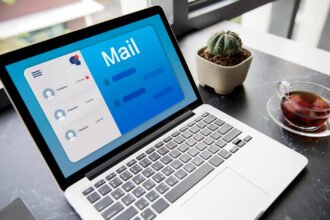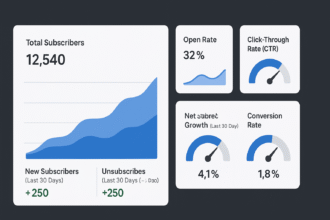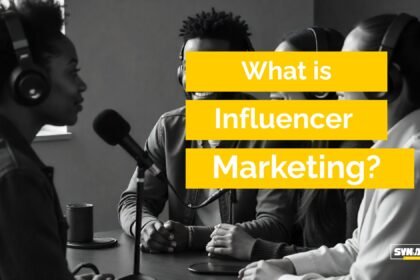“You’ve heard the terms. You’ve probably used both. But do you actually know what is the difference between email marketing and email automation?”
Chances are, you’ve fired off a few email blasts, scheduled some newsletters, maybe even set up a basic welcome sequence—and thought, Boom. I’m doing email marketing.
Or… was that email automation?
If you’re squinting at the screen right now wondering, wait, aren’t they the same thing?—you’re not alone. Many marketers use these terms interchangeably. But here’s the kicker: the difference between email marketing and email automation could be the line between sending messages that get ignored—and ones that drive real revenue.
Let’s be crystal clear:
Email marketing is the strategy.
Email automation is the system that makes that strategy scalable, smarter, and way more profitable.
Understanding what is the difference between email marketing and email automation isn’t just digital semantics—it’s about ROI. It’s about personalizing customer journeys at scale. It’s about leveraging drip campaigns, optimizing your email campaigns, and using smart marketing automation to turn passive subscribers into active buyers.
Here’s the stat that should stop you mid-scroll:
Businesses that use email automation see 320% more revenue from their campaigns than those that don’t.
— Campaign Monitor, 2024
So whether you’re a small business owner looking to grow your list, a startup founder trying to boost conversions, or a CMO ready to scale personalized engagement—this breakdown will show you how to wield both tools strategically, not just technically.
Also Read: How Do I Start Email Marketing?
Let’s dive into what is the difference between email marketing and email automation—and why knowing that difference changes everything.
Understanding the Basics: Email Marketing vs Email Automation
Before we dive deep into comparisons, we need to strip both concepts down to their core. To truly understand what is the difference between email marketing and email automation, you’ve got to know what each one actually does—and doesn’t do.
What Is Email Marketing, Really?
Think of email marketing as your foundational communication strategy. It’s the digital version of a megaphone—but smarter. You’re sending a message (or series of messages) to a curated list of people who’ve opted in. That might be a weekly newsletter, a promotional offer, or a seasonal update.
But here’s the thing: email marketing is largely manual or scheduled. You decide when to send. You decide who gets it. And while you might segment your list into different groups, the process still involves a lot of hand-holding.
Core Characteristics of Email Marketing:
- One-off email blasts or scheduled campaigns
- Focused on list segmentation and content design
- Manual timing or fixed schedules
- Metrics include open rate, click-through rate, and unsubscribe rate
- Includes basic personalization (e.g., first names, dynamic subject lines)
Example: A clothing brand sends a “50% Off Summer Sale” email to their subscriber list on a Friday morning.
Stat to know:
Email marketing yields an average ROI of $42 for every $1 spent.
— Data & Marketing Association, 2024
While effective, email marketing has its limits—especially when your audience starts to grow and their behaviors start to diverge. That’s where email automation steps in.
What Is Email Automation (And Why It’s Smarter)?
Email automation is like hiring a marketing assistant that works 24/7—except it never takes breaks, forgets a task, or sends the wrong message. It’s not just about sending emails—it’s about sending the right email at the exact right moment, based on user behavior and engagement triggers.
With email automation, your emails are no longer reactive—they’re proactive. You’re crafting drip campaigns, setting up transactional emails, automating onboarding sequences, and integrating with your CRM for hyper-personalized targeting.
Core Characteristics of Email Automation:
- Trigger-based workflows (based on user actions like sign-ups, downloads, purchases)
- Built-in sequences (e.g., welcome series, abandoned cart recovery)
- Uses lead scoring, behavioral tracking, and advanced segmentation
- Integrates with other channels (social, SMS, CRM)
- Personalization goes beyond names—down to browsing behavior, preferences, and purchase history
Example: Someone adds a product to their cart but doesn’t check out. Two hours later, they receive an automated email reminder—followed by a discount offer 24 hours later.
Stat to know:
Businesses using marketing automation for nurturing leads see a 451% increase in qualified leads.
— Annuitas Group, 2023
So if you’re still asking what is the difference between email marketing and email automation, here’s the short version:
Email marketing sends messages. Email automation creates experiences.
Now let’s break it down side-by-side.
Email Marketing vs Email Automation: How They Actually Differ
To truly grasp what is the difference between email marketing and email automation, let’s zoom out and look at the mechanics, strategy, and impact side-by-side. What you’ll see is this: while both tools use email as the medium, their goals, capabilities, and results are wildly different.
Here’s a no-fluff breakdown:
| Feature | Email Marketing | Email Automation |
| Primary Function | Manual or scheduled sends to segmented lists | Triggered emails based on real-time user behavior |
| Personalization | Basic (name, location, segment) | Advanced (dynamic content, behavioral targeting, lead scoring) |
| Timing | Set by sender (weekly, monthly, campaign-based) | Set by user action (onboarding, cart abandonment, downloads) |
| Analytics | Open/click-through/unsubscribe rates | Lifecycle tracking, user journey mapping, revenue attribution |
| Channels | Email only | Multichannel (email + SMS, CRM, push notifications, social) |
| Use Cases | Promotions, announcements, newsletters | Drip campaigns, onboarding, post-purchase, re-engagement sequences |
| Tools | Mailchimp, Moosend, Constant Contact | Klaviyo, ActiveCampaign, HubSpot, ConvertKit |
| Keyword Focus | email campaign, email blast, email marketing strategy | email automation, drip campaign, marketing automation tools |
| Scalability | Moderate—requires human scheduling | High—runs 24/7, infinitely scalable |
| Conversion Power | Good—especially for awareness and promotions | Excellent—for lifecycle nurturing and personalized conversion paths |
Real-World Example:
Let’s say you run an online bookstore.
- Email Marketing Approach: You send a newsletter every Friday featuring top picks, promotions, and a staff recommendation. Everyone on your list gets the same email—maybe segmented by genre preference if you’re fancy.
- Email Automation Approach: A visitor browses your site, clicks on a crime thriller, but doesn’t buy. Later that evening, they receive an automated email: “Still thinking about thrillers? Here’s 10% off our bestsellers.” The next day, they get another: “5 gripping crime novels everyone’s talking about.”
One’s a broadcast. The other’s a conversation.
So… Why Does This Difference Matter?
Because time is money, and attention is gold.
Email marketing gets your message out.
Email automation brings your audience in—closer, deeper, more engaged.
When someone asks “what is the difference between email marketing and email automation?”, they’re really asking:
“Do I want to talk at my audience—or talk with them?”
And in 2025, the brands that are winning are doing the latter—at scale, with precision, and on autopilot.
Use Cases: When to Use Email Marketing vs Email Automation
You don’t have to choose sides. In fact, the smartest marketers today are blending email marketing and email automation to create seamless, high-converting customer journeys.
But to use both effectively, you need to know when to hit “Send” and when to set things on autopilot.
Let’s explore the ideal use cases for each—because understanding what is the difference between email marketing and email automation also means knowing when to deploy one versus the other.
When to Use Email Marketing
If you’ve got a short-term goal, a one-off message, or something time-sensitive, email marketing is your go-to.
Perfect for:
- Newsletters: Regular updates to keep your audience informed and engaged.
- Flash Sales & Promotions: Got a weekend sale? Send a bulk email blast.
- Product Launches: Announce your latest offering to your list with excitement.
- Event Invitations: Promote a webinar, virtual conference, or product demo.
- Seasonal Campaigns: Holiday sales, end-of-year roundups, Black Friday promos.
Think: Broadcast messaging. Immediate reach. One-and-done.
Example:
A SaaS company emails their entire user base about a limited-time discount on annual plans, segmented by existing plan tiers.
When to Use Email Automation
Now, if you’re playing the long game—building relationships, nurturing leads, increasing lifetime value—this is where email automation shines.
Ideal for:
- Welcome Series: A multi-step drip campaign to introduce new subscribers to your brand.
- Lead Nurturing: Automatically send content based on the user’s interaction with your website or product.
- Abandoned Cart Recovery: Follow up when someone leaves a product behind.
- Post-Purchase Follow-Up: Thank-you emails, product care tips, upsell suggestions.
- Re-Engagement Campaigns: Win back dormant subscribers with targeted offers.
- Onboarding Flows: Step-by-step education or tutorials based on feature usage.
Think: Lifecycle marketing. Real-time triggers. Ongoing engagement.
Example:
An eCommerce brand uses a behavioral drip campaign where a shopper who buys a yoga mat gets follow-up emails recommending yoga blocks, stretching routines, and a playlist—over the next 7 days.
The Smartest Strategy: Use Both—Strategically
You wouldn’t build a house with just a hammer. Same goes for your marketing strategy.
When someone asks you again, “what is the difference between email marketing and email automation?”—you now know the answer isn’t just about definition. It’s about application.
Stat You Should Know:
Automated email workflows drive 80% higher open rates and 3x more click-throughs than manual campaigns.
— MoEngage, 2024
Tools of the Trade: Platforms for Email Marketing vs Email Automation
Now that you’ve nailed the theory behind what is the difference between email marketing and email automation, let’s get into the toolbox. Because the right platform can mean the difference between chaos and clarity, between sending emails… and actually making money from them.
Some platforms are built for straightforward campaigns. Others are beasts built for behavioral logic, integrations, and automated sequences. Use the wrong one—and you’ll feel it fast.
Best Platforms for Email Marketing
These tools are perfect if your primary needs are sending newsletters, building lists, and managing campaign content.
Top Picks:
- Mailchimp – Beginner-friendly, great for newsletters and small business campaigns.
- Moosend – Clean UI, solid automation features even at the free tier.
- Constant Contact – Robust templates and strong customer support.
- Benchmark Email – Known for simplicity and strong deliverability rates.
- MailerLite – Affordable and packed with value for small teams.
Best For:
Solopreneurs, nonprofits, startups, and anyone who wants to manage a reliable email campaign strategy without deep automation complexity.
“If your focus is strong copy, clean design, and consistent outreach, these are your go-to platforms for foundational email marketing.”
Best Platforms for Email Automation
Now, if you’re looking to build intelligent workflows, nurture leads across channels, and personalize at scale—automation-ready tools are your playground.
Top Picks:
- Klaviyo – Built for eCommerce; powerful segmentation and product-driven automations.
- ActiveCampaign – Full-stack automation with CRM, tagging, and behavior-based logic.
- HubSpot – Enterprise-level workflows with lead scoring and integrated CRM.
- ConvertKit – A favorite among creators and educators with smart sequences and tagging.
- Drip – Made for eCommerce marketers who need high-conversion automation.
Best For:
Scaling businesses, SaaS startups, eCommerce stores, and anyone serious about drip campaigns, marketing automation, and omnichannel orchestration.
“If your strategy involves nurturing, cross-selling, onboarding, or reactivating at scale—email automation is your revenue engine.”
Platform Decision Matrix:
| Your Goal | Use This | Why |
| Send weekly newsletters | Mailchimp, MailerLite | Easy scheduling, templates, simple list management |
| Build a welcome series | ConvertKit, Moosend | User-friendly automation with tagging |
| Recover abandoned carts | Klaviyo, ActiveCampaign | Event-triggered flows based on shopping behavior |
| Sync email with CRM + sales pipelines | HubSpot, ActiveCampaign | Native CRM and deep automation logic |
| Sell more products via personalization | Drip, Klaviyo | Dynamic content based on browsing, purchases, and product tags |
Tip:
Before choosing a tool, write down what you want to achieve. Start with strategy, not software. Then reverse-engineer the platform that supports it.
Bottom line?
To truly leverage what is the difference between email marketing and email automation, you need to pick the right tools that align with your goals, your audience, and your bandwidth.
Why It Matters: The Real-World Impact of Choosing the Right Strategy
Let’s cut to the chase: knowing what is the difference between email marketing and email automation isn’t just some geeky digital trivia. It’s a bottom-line question—a conversion question—a growth question.
Because when you get this wrong?
You waste time, bleed leads, and annoy your audience.
When you get it right?
You turn your inbox into a pipeline. And you do it on autopilot.
Email Marketing: High Engagement, Lower Scalability
Traditional email marketing shines when you’re building awareness, announcing limited-time offers, or keeping your audience looped in. It’s still one of the highest ROI channels out there.
But here’s the catch: it’s manual, reactive, and gets overwhelming to manage as you grow.
Stat Check:
Email marketing is ranked as the top-performing channel for ROI, averaging $42 per $1 spent.
— DMA, 2024
Use it when you want control, creative flexibility, and a fast time-to-launch.
Email Automation: Scalable, Predictable Revenue
Email automation, on the other hand, doesn’t just engage—it converts. With behavior-driven triggers, you’re showing up exactly when your subscriber is most likely to take action.
It’s smart. It’s scalable. It’s the difference between generic messages and meaningful moments.
Stat Check:
Automated emails drive 320% more revenue and 4x more engagement than manual email campaigns.
— Campaign Monitor, 2024
Use it when you’re serious about nurturing leads, boosting retention, and maximizing LTV.
What Happens When You Ignore the Difference?
Let’s keep it real: if you’re still batching and blasting your list with one-size-fits-all messaging, here’s what you’ll start to see:
- Plummeting open rates
- Higher unsubscribe rates
- Missed opportunities for upselling and re-engagement
- Zero personalization (which is now the baseline, not the bonus)
You don’t have to be a tech wizard or enterprise brand to fix it. You just need to understand the strategic use case for each approach.
Breakdown
- Email marketing is your megaphone: loud, clear, scheduled.
- Email automation is your AI assistant: targeted, timely, always working.
And the smartest brands?
They don’t pick one over the other—they know when to use each.
Frequently Asked Questions: Expert Answers to Common Questions
You’ve made it this far—so you’re clearly serious about leveling up. But before we wrap, let’s crush a few of the most common misconceptions floating around about email marketing and email automation.
Because if you’re still asking what is the difference between email marketing and email automation, chances are you’ve heard (or believed) at least one of these:
Is Email Automation Replacing Email Marketing?
Nope. Not even close.
Automation isn’t a replacement—it’s an evolution.
You still need solid copy, a killer subject line, and a clear goal. Automation just makes it easier to scale those efforts, target smarter, and convert better.
Think of email marketing as the message, and automation as the delivery system that gets it to the right person at the perfect time.
Can Small Businesses Use Email Automation Effectively?
Absolutely—and they should.
You don’t need an enterprise budget or a 10-person tech team.
Tools like MailerLite, Moosend, ConvertKit, and ActiveCampaign make it ridiculously easy to set up simple automations like:
- Welcome sequences
- Abandoned cart recovery
- Lead nurturing drip campaigns
Tip: Start small. Even one automation flow can deliver serious ROI.
Are Drip Campaigns Part of Email Marketing or Automation?
They’re a key part of email automation.
A drip campaign is a pre-scheduled series of emails triggered by user behavior (like signing up, clicking a link, or making a purchase).
It’s one of the most powerful tactics inside an automation system—and helps nurture leads without lifting a finger.
In short: You set it once, it works forever.
How Do I Know If I’m Actually Using Automation?
Ask yourself:
- Are your emails sent because someone did something (like signed up or clicked)?
- Do you have flows or sequences triggered by user behavior?
- Can your system segment people automatically based on actions?
If the answer is no to all three…
You’re doing traditional email marketing—not automation.
What’s the Real Benefit of Understanding the Difference?
Knowing what is the difference between email marketing and email automation helps you:
- Use the right tools at the right time
- Build smarter customer journeys
- Personalize at scale without burning out
- Generate more revenue with less manual work
Bottom line: It’s about working smarter, not harder.
Final Verdict: Which Should You Use—and When?
Let’s bring it home.
If you’ve stuck with us through this breakdown, you already know the answer to what is the difference between email marketing and email automation isn’t just technical—it’s transformational.
These aren’t competing tools. They’re complementary weapons in your marketing arsenal. Used together, they help you move from mass messaging to meaningful, personalized experiences.
Recap:
| Use Email Marketing When… | Use Email Automation When… |
| You’re running a flash sale | You want to onboard new customers with a sequence |
| You’re sending a weekly newsletter | You want to re-engage dormant subscribers |
| You’re promoting an event or product launch | You want to recover abandoned carts automatically |
| You’re just getting started with list-building | You want to nurture leads until they’re ready to convert |
| You need to send one-time announcements to your list | You want to personalize content based on behavior |
Your Action Plan:
- Audit Your Current System:
Are you manually sending every campaign? You’re leaving conversions on the table. - Start with One Automation:
Try a simple welcome sequence, cart reminder, or re-engagement flow. Let it run. - Blend Tactics Strategically:
Use email marketing for high-impact broadcasts and automation for long-term nurturing. - Measure Everything:
Open rates are vanity. Look at conversions, lifetime value, and time saved. - Upgrade Your Tools if Needed:
If your platform doesn’t support automation, it might be time to level up.
Final Word from the Expert:
“Email marketing speaks to the crowd. Email automation speaks to the individual. The brands that master both? They don’t just get clicks—they build loyalty, trust, and revenue that lasts.”
— William June, Content Generation Specialist
Need More Help?
If you’re unsure how to get started with automation—or want a full strategy that blends both approaches—reach out. Whether you’re a solo founder, growth marketer, or brand scaling to the next level, we’ve got the tools and tactics to help.
Now that you understand what is the difference between email marketing and email automation, the only question left is:
What will you automate first?
Our Done For You Free Starter Toolkit Email Automation
Best Email Automation Tools (By Use Case)
| Tool | Best For | Why It’s Great |
| Klaviyo | eCommerce brands | Deep Shopify integration, product-based flows, advanced segmentation |
| ConvertKit | Creators, coaches, bloggers | Simple UI, visual automation builder, tags + rules system |
| MailerLite | Small businesses, startups | Affordable, intuitive, strong automation features (even on free plan) |
| ActiveCampaign | Mid-sized businesses, B2B marketers | Built-in CRM, conditional flows, lead scoring, excellent analytics |
| Moosend | Budget-conscious marketers | Great value, prebuilt automations, dynamic email content |
| Drip | eCommerce and DTC brands | Revenue-focused flows, abandoned cart recovery, deep tracking |
Our Done-for-You Automation Templates
Plug-and-play templates you can customize for your business in minutes:
- Welcome Sequence (3-part drip):
- Day 0: Welcome + what to expect
- Day 2: Value-packed resource or story
- Day 5: Soft sell / product intro
- Abandoned Cart Series:
- 1 hr later: Reminder with product image
- 24 hrs later: Social proof + urgency
- 48 hrs later: Discount incentive (optional)
- Lead Magnet Delivery + Nurture Flow:
- Day 0: Deliver the freebie
- Day 1: Add value with a tip or tool
- Day 3: Soft CTA for next step (book a call, visit product page)
- Post-Purchase Upsell Series:
- Day 1: Thank you + product usage guide
- Day 3: Cross-sell suggestions
- Day 7: Ask for review / testimonial
- Re-engagement Campaign (Win-back):
- Subject: “Still interested?”
- Include: A quick poll or offer to reconnect
- Final email: “We’ll miss you”—FOMO + unsubscribe option
Automation Triggers You Can Set Right Away
- When someone signs up for your list → Start a welcome series
- When a cart is abandoned → Launch recovery flow
- After a product is purchased → Send usage tips + upsell
- When a subscriber hasn’t opened emails in 30+ days → Run re-engagement
- When someone clicks a specific link → Tag + shift to new sequence
Bonus: Tools to Supercharge Your Automations
- Zapier – Connect apps like Shopify, Calendly, Notion, and more to trigger automations
- Typeform / Tally – Collect lead data + send to your email tool
- Canva – Design email headers, product images, and branded templates
- Google Sheets + Zapier – Automatically store responses, sign-ups, or customer actions
- SegMetrics / Fathom Analytics – Track actual revenue from your automated sequences
Your 7-Day Kickoff Plan
| Day | Action |
| Day 1 | Choose your email automation platform |
| Day 2 | Set up your first list and welcome email |
| Day 3 | Build a basic welcome automation sequence |
| Day 4 | Add a form or lead magnet to your site |
| Day 5 | Set up your first abandoned cart flow |
| Day 6 | Track opens, clicks, and replies |
| Day 7 | Optimize based on what’s working! |








